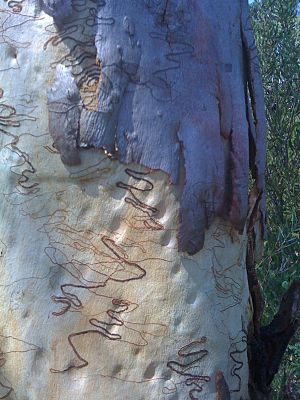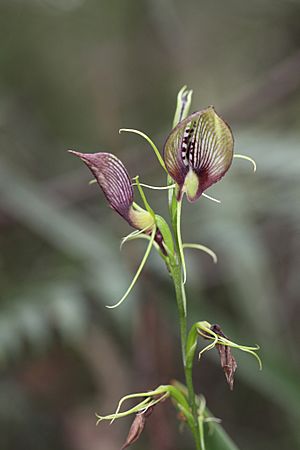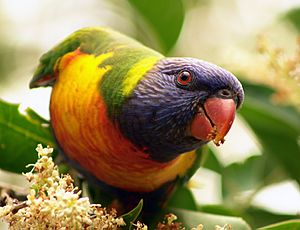Caravan Head Bushland Reserve facts for kids
The Caravan Head Bushland Reserve is a special natural area in Oyster Bay, which is in southern Sydney, New South Wales, Australia. It's about 2.2 hectares big, which is like four football fields! This reserve is a protected space for native plants and animals. It's bordered by Caravan Head Road, Cook Road, and some private homes.
This land was originally set aside for a school that was never built. Later, there were plans to develop it, but local people wanted to protect the bushland. Thanks to their efforts and political support, the government bought the land. It then became a bushland reserve.
In its early days, the reserve was damaged by bike tracks and vegetation removal. But for over ten years, a local Bushcare Group has worked hard to restore it. These volunteers have helped bring the bushland back to its natural state. They continue to look after it to keep it healthy.
The reserve has many different types of native plants. On the eastern side, you can find a dense forest of Callitris rhomboidea (Port Jackson pine). Most of the reserve has woodlands with tall trees like Corymbia gummifera (red bloodwoods), Angophora costata (Sydney rosegum), and Eucalyptus haemastoma (scribbly gums). The ground is mostly sandy, but in the north, there are large Sydney sandstone boulders. These rocks have helped protect a wider variety of plants growing on the ground. Over 150 different native plant species have been found here!
Contents
Amazing Plants of the Reserve
The reserve is home to many interesting plants, from tall trees to tiny orchids.
Shrubs and Undergrowth
You can find many types of shrubs here. Some common ones include Hakea sericea (silky hakea) and Hakea dactyloides (broad-leaved hakea). There are also different wattles like Acacia terminalis (sunshine wattle) and Acacia linifolia (flax-leafed wattle). Other shrubs include Petrophile pulchella (conesticks) and Angophora hispida (dwarf apple). You might also spot Banksia spinulosa (hairpin banksia) and Allocasuarina littoralis (black she-oaks).
Closer to the ground, you'll see many herbs and climbing plants. These include Hardenbergia violacea (purple twining pea) and Smilax australis (native sarsaparilla). Look out for Dianella caerulea (blue flax lily) and Lindsaea linearis (screw fern). There are also pretty flowers like Hibbertia riparia (Guinea flower) and Actinotus minor (lesser flannel flower).
Grasses and Orchids
The reserve also has various native grasses. These include Micrloaena stipoides (weeping meadow grass) and Themeda triandra (kangaroo grass). You might also see Echinopogon caespitosus (hedgehog grass) and Cymbopogon refractus (barbed-wire grass).
Tiny Orchids also grow here. Their leaves are so small they can look like blades of grass. They often hide away in hot weather, waiting for rain to bloom. Some orchid species found are Theylmitra pauciflora and Cryptostylis erecta.
Wildlife in the Reserve
Caravan Head Bushland Reserve is a home or visiting spot for many native animals.
Birds
Many birds enjoy this bushland. You can often hear the calls of the Pied currawong and Australian magpie. Other common birds include the Noisy miner and the famous Laughing kookaburra. Brightly coloured Trichoglossus moluccanus (rainbow lorikeets) fly through the trees. You might also see large birds like the Yellow-tailed black cockatoo and Sulphur-crested cockatoo. The Tawny frogmouth, which looks like a tree branch, also lives here. Sadly, some birds like the Superb fairywren and Silvereye used to live here but are not seen anymore.
Mammals
Mammals in the reserve are mostly limited to nocturnal animals. You might spot a Pseudocheiridae (ringtail possum) or a Brushtail possum. Both are important native animals. Pteropus (grey-headed flying foxes) also visit the reserve. These bats are a threatened species. The reserve is also home to native rodents and various tiny micro-bat species, many of which are also threatened.
Challenges for the Reserve
Like many natural areas, Caravan Head Bushland Reserve faces some challenges.
Weeds and Pests
Weed species can grow quickly and take over native plants. Some common weeds found here include panic veldt grass and Lantana camara. Pittosporum undulatum is a native plant that can become a weed when conditions change. Other problem plants are Blechnum nudum (fishbone fern) and asparagus fern.
Feral animals also cause problems for the native wildlife. These include the Red fox, domestic cat, domestic dog, and the Common myna bird. These animals can hunt native species or compete for food and homes. The Bushcare Group works hard to manage these issues and protect the reserve's natural balance.




